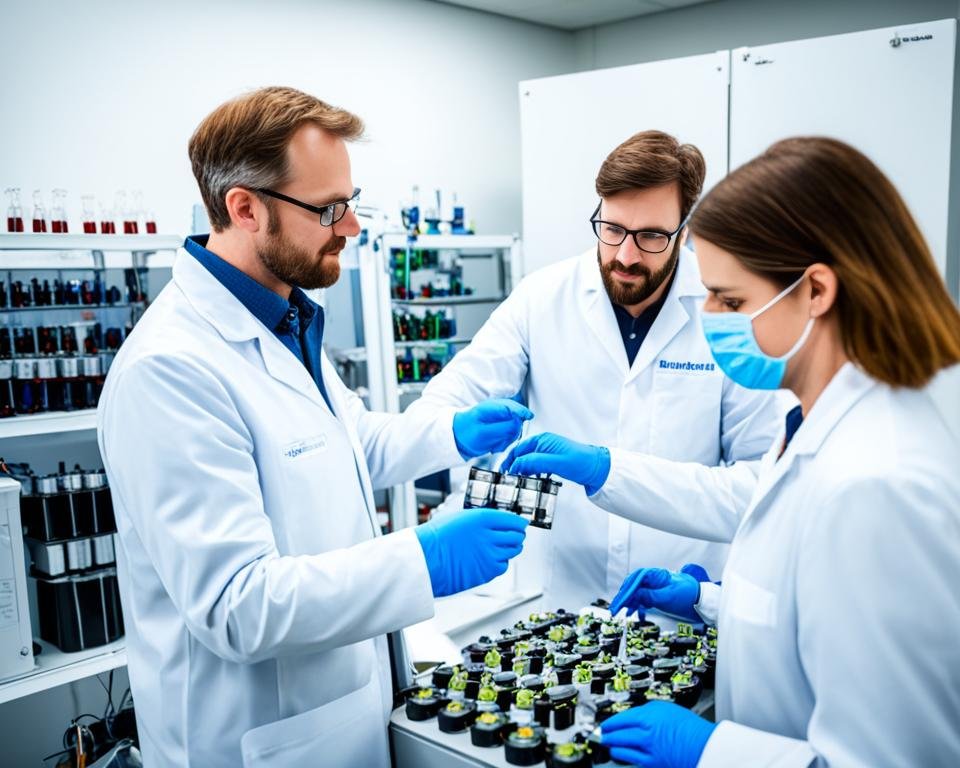In this article, we will explore the various applications and uses of vanadium. From steel alloys to batteries, vanadium plays a crucial role in shaping different industries.
Key Takeaways:
- Vanadium is commonly used in the production of steel alloys, enhancing their strength and durability.
- Vanadium redox flow batteries are essential for large-scale energy storage and are key to renewable energy integration.
- Vanadium compounds serve as catalysts in chemical reactions, promoting the conversion of raw materials into useful products.
- Vanadium is employed in the production of pigments for ceramics, glass, and paints, providing vibrant colors and excellent lightfastness properties.
- Vanadium alloys are utilized in aerospace applications due to their strength-to-weight ratio and heat resistance.
Vanadium in Steel Alloys

Vanadium plays a critical role in the production of steel alloys, contributing to their exceptional strength, durability, and heat resistance. It is extensively used in various industries, including construction, automotive, and aerospace.
Steel alloys enriched with vanadium exhibit enhanced mechanical properties, making them ideal for applications that require high performance and reliability. The addition of vanadium refines the microstructure of steel, improving its overall toughness and wear resistance.
Furthermore, vanadium aids in the formation of carbides, which further strengthen the steel matrix. This unique ability allows steel alloys containing vanadium to maintain their structural integrity, even under extreme temperatures and challenging environments.
The utilization of vanadium in steel alloys offers numerous benefits. It allows for the construction of lighter-weight structures without compromising strength, ensuring fuel efficiency in the automotive sector. In the aerospace industry, vanadium-enriched alloys enable the development of aircraft parts that can withstand the demanding conditions of flight.
Moreover, vanadium’s presence in the construction industry contributes to the construction of sturdy buildings, bridges, and infrastructure that can withstand potential stress and load factors.
Overall, vanadium’s role in steel alloys is instrumental in pushing the boundaries of material science, delivering robust and high-performance materials for critical applications.
Key Advantages of Vanadium in Steel Alloys
- Enhanced strength and durability
- Improved heat resistance
- Increased toughness and wear resistance
- Lightweight construction
“The addition of vanadium to steel alloys significantly improves their mechanical properties, allowing for the development of lightweight yet strong structures that can withstand demanding conditions.”
| Application | Advantages |
|---|---|
| Construction | – Increased structural integrity |
| Automotive | – Fuel efficiency – Improved crash resistance |
| Aerospace | – High temperature resistance – Enhanced performance |
Vanadium Redox Flow Batteries

Vanadium plays a crucial role in the development and implementation of vanadium redox flow batteries (VRFBs). These rechargeable batteries are specifically designed for large-scale energy storage, making them essential for renewable energy integration and grid stabilization.
One of the key advantages of VRFBs is their ability to store and release large amounts of energy. This makes them ideal for applications that require long-duration energy storage, such as power grid stabilization, load shifting, and backup power systems.
How do vanadium redox flow batteries work? Here’s a simplified explanation:
- Electrolytes: VRFBs use vanadium electrolytes, which consist of two tanks – one with a positive vanadium solution (V(5+)) and another with a negative vanadium solution (V(2+)). The solutions are separated by a membrane that allows the transfer of ions but prevents the mixing of electrolytes.
- Charging: During the charging process, electricity is applied to the VRFB, causing the vanadium ions in the positive electrolyte to gain electrons and convert into V(4+). At the same time, the vanadium ions in the negative electrolyte lose electrons and convert into V(3+).
- Discharging: When energy is needed, the process is reversed. The V(4+) ions in the positive electrolyte release electrons and convert back into V(5+), while the V(3+) ions in the negative electrolyte accept electrons and convert back into V(2+).
This unique design allows VRFBs to have a long cycle life, as the vanadium electrolytes can be charged and discharged repeatedly without significant degradation. Additionally, VRFBs offer a high energy efficiency and can be easily scaled up to meet the demands of large power grids.
With the increasing focus on renewable energy sources, vanadium redox flow batteries are gaining prominence as an important component of the future energy landscape. Their ability to store and supply large amounts of clean energy makes them a key enabler for a sustainable and resilient power infrastructure.
| Advantages of Vanadium Redox Flow Batteries | Challenges of Vanadium Redox Flow Batteries |
|---|---|
|
|
Vanadium in Chemical Catalysts

Vanadium compounds play a critical role as catalysts in various chemical reactions across multiple industries. Acting as catalysts, these compounds facilitate the conversion of raw materials into valuable products, advancing processes in sectors such as petrochemicals, pharmaceuticals, and environmental technologies.
Vanadium-based catalysts offer several advantages, including high selectivity, efficiency, and stability. Their unique chemical properties enable them to accelerate reaction rates and control the desired outcomes, resulting in improved yields and reduced energy consumption.
In the petrochemical industry, vanadium catalysts are utilized in the production of various essential chemicals, such as sulfuric acid, acetic acid, and phthalic anhydride. These catalysts enable the synthesis of these compounds with high precision and efficiency, facilitating the manufacturing processes.
Furthermore, the pharmaceutical industry relies on vanadium catalysts for the synthesis of complex organic molecules, including pharmaceutical intermediates and active pharmaceutical ingredients (APIs). The use of vanadium catalysts in pharmaceutical manufacturing offers greater efficiency, cost-effectiveness, and environmental sustainability.
Vanadium catalysts also find application in environmental technologies, particularly in emissions control systems. By promoting the conversion of harmful pollutants into less toxic substances, these catalysts contribute to reducing air pollution and improving air quality.
“Vanadium catalysts play a significant role in our daily lives by driving various chemical reactions with high efficiency and selectivity. They have revolutionized industries such as petrochemicals, pharmaceuticals, and environmental technologies, enabling sustainable and cleaner processes.”
Benefits of Vanadium Catalysts:
- Enhanced reaction rates and selectivity
- Improved yields and efficiency
- Reduced energy consumption
- Greater control over desired outcomes
- Cost-effectiveness and environmental sustainability
Overall, vanadium compounds as catalysts play a pivotal role in driving chemical reactions, enabling the production of valuable products across various industries. Their unique properties and versatility make them indispensable in advancing technological advancements, improving process efficiency, and fostering sustainable development.
Vanadium in Pigments

Vanadium compounds are employed in the production of pigments for ceramics, glass, and paints. These pigments provide vibrant colors and excellent lightfastness properties.
Pigments containing vanadium are widely used in various artistic and industrial applications. The bright and intense hues produced by vanadium-based pigments make them a popular choice for artists, decorators, and manufacturers.
One of the most notable vanadium pigments is vanadium yellow, also known as vanadium chrome yellow. This pigment has a vivid yellow color and is highly valued for its exceptional lightfastness, meaning it resists fading when exposed to light over time.
Vanadium yellow is particularly favored in ceramics, where its vibrant color adds depth and richness to glazes, tiles, and decorative pieces. It is also used in the production of high-quality glass to create brilliant, yellow-colored glassware and stained glass windows.
In the paint industry, vanadium-based pigments are commonly used for their ability to produce a broad range of colors with excellent color stability. From warm oranges and reds to cool greens and blues, these pigments offer versatility and durability to paint formulations.
| Pigment Name | Color | Applications |
|---|---|---|
| Vanadium Yellow | Yellow | Ceramics, Glass, Paints |
| Vanadium Green | Green | Ceramics, Glass, Paints |
| Vanadium Blue | Blue | Ceramics, Glass, Paints |
| Vanadium Red | Red | Ceramics, Glass, Paints |
Vanadium pigments not only provide aesthetic value but also possess excellent chemical properties. They exhibit good color retention, resistance to heat and chemicals, ensuring that the colors remain vibrant and intact in various environments and applications.
The image above showcases the stunning colors achieved with vanadium pigments in ceramics and glass. From the golden hues of vanadium yellow to the vibrant blues of vanadium blue, these pigments add beauty and depth to artistic creations.
Vanadium in Aerospace Applications

Vanadium alloys play a crucial role in aerospace applications, offering exceptional strength-to-weight ratio and heat resistance that are essential for the demanding conditions of flight. These alloys are used in various critical components, including jet engines and airframes, ensuring the highest standards of safety and performance.
One of the primary reasons vanadium alloys are favored in aerospace is their ability to withstand high temperatures, making them ideal for engine components such as turbine blades and nozzles. The exceptional heat resistance of vanadium alloys allows engines to operate efficiently at extreme conditions, maximizing thrust and fuel efficiency.
Additionally, vanadium alloys contribute significantly to the overall structural integrity of airframes, providing strength and durability while keeping weight to a minimum. This lightweight characteristic not only enhances fuel efficiency but also increases payload capacity, allowing for more passengers or cargo to be transported.
The use of vanadium alloys in aerospace applications is not limited to engines and airframes. These alloys are also utilized in critical components such as landing gear and hydraulic systems, where strength, durability, and corrosion resistance are essential qualities. By ensuring the reliability and longevity of these components, vanadium alloys play a vital role in ensuring the safety of aircraft.
With its superior properties, vanadium allows for advancements in aerospace technology, pushing the boundaries of what is possible in terms of performance, efficiency, and safety. As the aerospace industry continues to evolve and innovate, vanadium alloys will remain a critical material for achieving new heights.
Vanadium in Chemical Storage

Vanadium plays a vital role in chemical storage systems, particularly in hydrogenation reactors. Acting as a catalyst, vanadium enables the crucial storage and release of hydrogen, an essential element in numerous industrial processes.
Hydrogenation reactors rely on vanadium to facilitate chemical reactions that involve the addition of hydrogen to substances. This process is commonly used in the production of various compounds, including fats, oils, and petrochemicals. Vanadium’s catalytic properties and ability to facilitate the bonding of hydrogen atoms make it an ideal choice for these reactors, ensuring efficient and effective storage of hydrogen.
Moreover, the use of vanadium in chemical storage systems extends beyond hydrogenation reactors. Vanadium compounds are also employed in other chemical processes for their ability to facilitate reactions, increase reaction rates, and improve overall efficiency.
“Vanadium’s role in chemical storage systems is instrumental in enhancing industrial processes and enabling the storage and release of hydrogen, a critical component in various applications.”
With vanadium’s involvement, industries can optimize their chemical storage methods, ensuring reliable and controlled storage of reactive substances. This not only enhances safety precautions but also promotes sustainability and efficiency in chemical production.
The Benefits of Vanadium in Chemical Storage:
- Facilitates the storage and release of hydrogen in hydrogenation reactors
- Enhances chemical reactions and reaction rates
- Improves the efficiency of chemical storage methods
- Promotes safety and sustainability in chemical production
The application of vanadium in chemical storage systems showcases its versatility and essential role in various industrial sectors. From facilitating reactions to ensuring the controlled storage of hydrogen, vanadium’s catalytic properties contribute significantly to the advancement and efficiency of chemical processes.
Vanadium in Nuclear Power

Vanadium plays an important role in the field of nuclear power due to its exceptional properties. It is utilized in certain components of nuclear reactors and nuclear fuel, thanks to its excellent corrosion resistance and high neutron absorption capacity. This makes vanadium a crucial element in ensuring the safety and efficiency of nuclear power plants.
One of the key applications of vanadium in nuclear power is in the construction of reactor vessels. These vessels contain the nuclear fuel and are subjected to extreme conditions, including high temperatures and intense radiation. Vanadium’s ability to withstand corrosion and its remarkable strength make it an ideal material for these critical components, ensuring the integrity and longevity of the reactor.
Furthermore, vanadium is employed in the production of control rods used in nuclear reactors. Control rods are responsible for regulating the fission process by absorbing neutrons. Vanadium’s high neutron absorption capacity allows it to effectively control the nuclear reaction, ensuring the stability and safety of the reactor.
Vanadium in Nuclear Power – Benefits and Applications
Here are some key benefits and applications of vanadium in nuclear power:
| Benefits | Applications |
|---|---|
| Excellent corrosion resistance | Reactor vessels |
| High neutron absorption capacity | Control rods |
Vanadium’s unique properties make it an invaluable component in nuclear power, contributing to the safe and efficient generation of electricity. Its corrosion resistance and neutron absorption capacity ensure the stability and longevity of nuclear reactors, making vanadium an essential material in the field of nuclear energy.
Conclusion
In conclusion, vanadium is a versatile element with wide-ranging applications across various industries. Its use in steel alloys enhances the strength and durability of construction materials, automotive components, and aerospace structures. Additionally, vanadium’s presence in vanadium redox flow batteries enables efficient large-scale energy storage, facilitating the integration of renewable energy sources into the power grid.
Vanadium compounds act as catalysts in chemical reactions, enabling the conversion of raw materials into valuable products in industries such as petrochemicals, pharmaceuticals, and environmental solutions. Moreover, vanadium pigments provide vibrant colors and excellent lightfastness properties in ceramics, glass, and paints.
Furthermore, vanadium alloys play a crucial role in aerospace applications due to their exceptional strength-to-weight ratio and resistance to high temperatures. They are utilized in critical components of jet engines, airframes, and other aerospace structures. Vanadium’s utility also extends to chemical storage systems, where it acts as a catalyst for the storage and release of hydrogen, a vital element in many industrial processes.
Last but not least, vanadium’s excellent corrosion resistance and high neutron absorption capacity make it suitable for use in some components of nuclear reactors and nuclear fuel, contributing to safe and efficient nuclear power generation. Overall, vanadium’s versatility drives technological advancements and supports societal progress across various industries.
FAQ
What are the uses of vanadium?
Vanadium has various applications, including its use in steel alloys, batteries, chemical catalysts, pigments, aerospace components, chemical storage systems, and even in nuclear power.
How is vanadium used in steel alloys?
Vanadium is added to steel alloys to enhance their strength, durability, and heat resistance. This makes vanadium-based steel ideal for applications in industries such as construction, automotive, and aerospace.
What are vanadium redox flow batteries?
Vanadium redox flow batteries are rechargeable batteries used for large-scale energy storage. Vanadium plays a key role in these batteries, enabling renewable energy integration and grid stabilization.
How is vanadium used in chemical catalysts?
Vanadium compounds are widely used as catalysts in chemical reactions. They facilitate the conversion of raw materials into useful products in industries such as petrochemical, pharmaceutical, and environmental sectors.
What is the role of vanadium in pigments?
Vanadium compounds are employed in the production of pigments for ceramics, glass, and paints. These pigments provide vibrant colors and excellent lightfastness properties.
How is vanadium used in aerospace applications?
Vanadium alloys are utilized in aerospace applications due to their exceptional strength-to-weight ratio and heat resistance. They are commonly used in jet engines, airframes, and other critical components.
How is vanadium used in chemical storage?
Vanadium is used in chemical storage systems, such as hydrogenation reactors, where it acts as a catalyst to enable the storage and release of hydrogen, an important element in many industrial processes.
What is vanadium’s role in nuclear power?
Vanadium is utilized in some components of nuclear reactors and nuclear fuel due to its excellent corrosion resistance and high neutron absorption capacity.
What are the key applications of vanadium?
Vanadium finds diverse applications in industries ranging from steel alloys to batteries, chemical catalysts to pigments, and even in aerospace and nuclear power.




